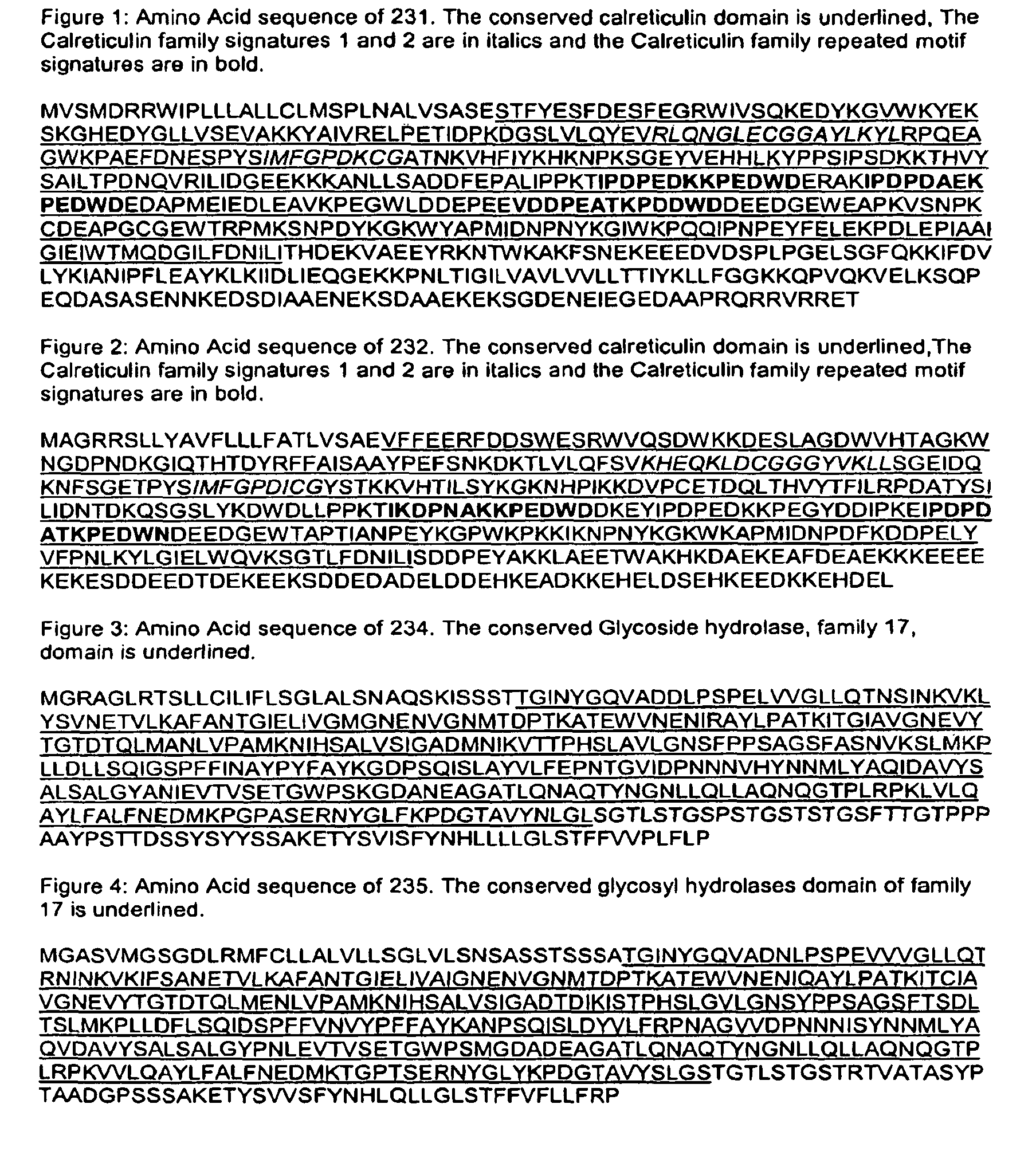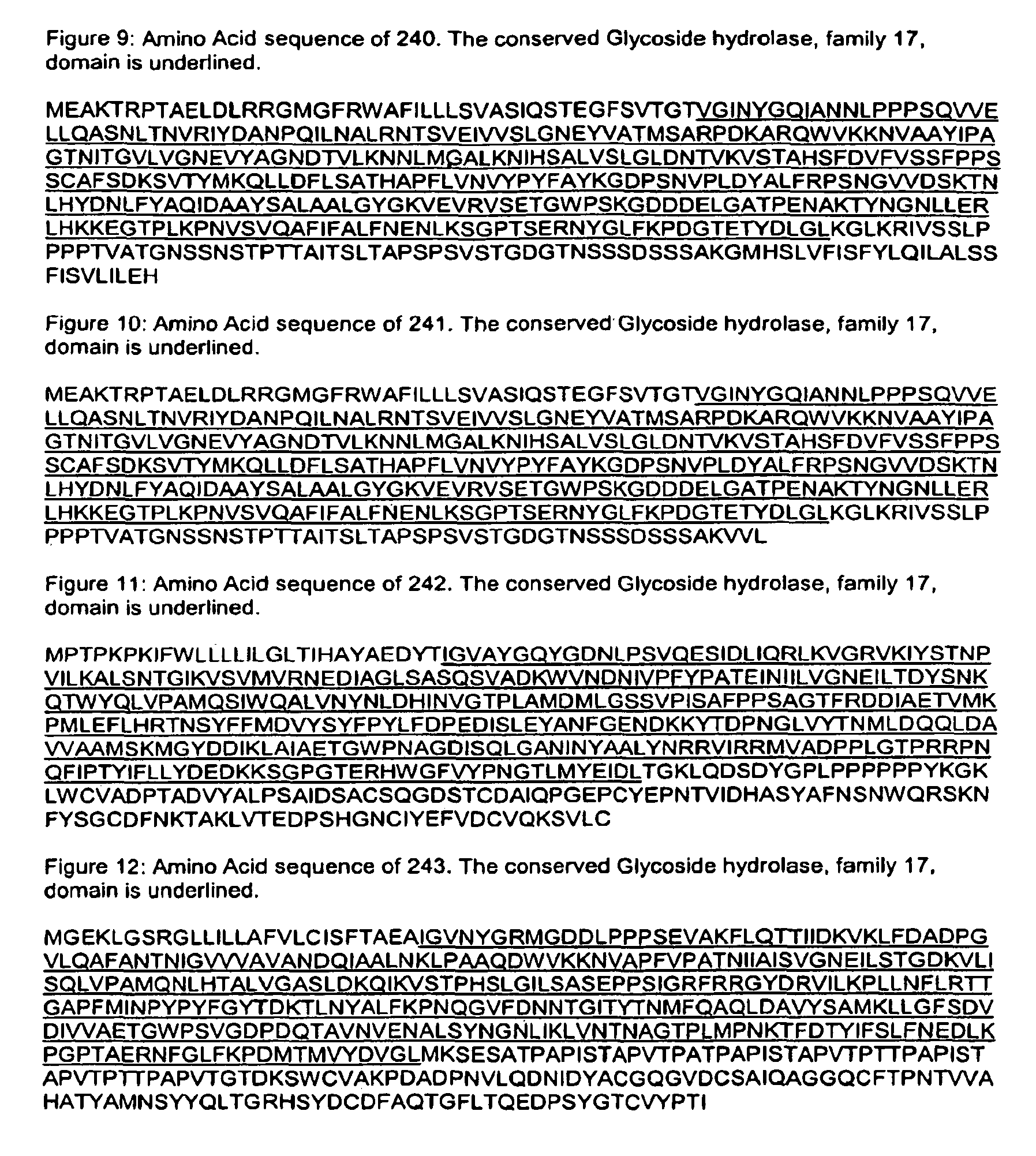Wood and cell wall gene microarray
a cell wall and gene technology, applied in the field of polynucleotide sequences isolated from plants, can solve the problems of high degree of environmental sensitivity, difficulty in determining the genes responsible for a given phenotype, and difficulty in comparing expression of more than a handful of genes, so as to improve drought tolerance, reduce or increase height, and reduce or increase volume
- Summary
- Abstract
- Description
- Claims
- Application Information
AI Technical Summary
Benefits of technology
Problems solved by technology
Method used
Image
Examples
example 1
Isolation and Characterization of cDNA Clones from Eucalyptus grandis
[0500]Eucalyptus grandis cDNA expression libraries were prepared from mature shoot buds, early wood phloem, floral tissue, leaf tissue (two independent libraries), feeder roots, structural roots, xylem or early wood xylem and were constructed and screened as follows.
[0501]Total RNA was extracted from the plant tissue using the protocol of Chang et al. (Plant Molecular Biology Reporter 11:113-116 (1993). mRNA was isolated from the total RNA preparation using either a Poly(A) Quik mRNA Isolation Kit (Stratagene, La Jolla, Calif.) or Dynal Beads Oligo (dT)25 (Dynal, Skogen, Norway). A cDNA expression library was constructed from the purified mRNA by reverse transcriptase synthesis followed by insertion of the resulting cDNA clones in Lambda ZAP using a ZAP Express cDNA Synthesis Kit (Stratagene), according to the manufacturer's protocol. The resulting cDNAs were packaged using a Gigapack II Packaging Extract (Stratag...
example 2
Isolation and Characterization of cDNA Clones from Pinus radiata
[0505]Pinus radiata cDNA expression libraries (prepared from either shoot bud tissue, suspension cultured cells, early wood phloem (two independent libraries), fascicle meristem tissue, male strobilus, root (unknown lineage), feeder roots, structural roots, female strobilus, cone primordia, female receptive cones and xylem (two independent libraries) were constructed and screened as described above in Example 1.
[0506]DNA sequence for positive clones was obtained using forward and reverse primers on a Perkin Elmer / Applied Biosystems Division Prism 377 sequencer and the determined sequences were compared to known sequences in the database as described above.
[0507]Based on similarity to known sequences from other plant species, the isolated polynucleotide sequences were identified as encoding wood and cell wall proteins, as displayed above in Table 1. The predicted polypeptide sequences corresponding to the polynucleotide...
example 3
5′ RACE Isolation
[0508]To identify additional sequence 5′ or 3′ of a partial cDNA sequence in a cDNA library, 5′ and 3′ rapid amplification of cDNA ends (RACE) was performed. Using the SMART RACE cDNA amplification kit (Clontech Laboratories, Palo Alto, Calif.). Generally, the method entailed first isolating poly(A) mRNA, performing first and second strand cDNA synthesis to generate double stranded cDNA, blunting cDNA ends, and then ligating of the SMART RACE. Adaptor to the cDNA to form a library of adaptor-ligated ds cDNA. Gene-specific primers were designed to be used along with adaptor specific primers for both 5′ and 3′ RACE reactions. Using 5′ and 3′ RACE reactions, 5′ and 3′ RACE fragments were obtained, sequenced, and cloned. The process may be repeated until 5′ and 3′ ends of the full-length gene were identified. A full-length cDNA may generated by PCR using primers specific to 5′ and 3′ ends of the gene by end-to-end PCR.
[0509]For example, to amplify the missing 5′ region ...
PUM
| Property | Measurement | Unit |
|---|---|---|
| temperature | aaaaa | aaaaa |
| temperature | aaaaa | aaaaa |
| pH | aaaaa | aaaaa |
Abstract
Description
Claims
Application Information
 Login to View More
Login to View More - R&D
- Intellectual Property
- Life Sciences
- Materials
- Tech Scout
- Unparalleled Data Quality
- Higher Quality Content
- 60% Fewer Hallucinations
Browse by: Latest US Patents, China's latest patents, Technical Efficacy Thesaurus, Application Domain, Technology Topic, Popular Technical Reports.
© 2025 PatSnap. All rights reserved.Legal|Privacy policy|Modern Slavery Act Transparency Statement|Sitemap|About US| Contact US: help@patsnap.com



